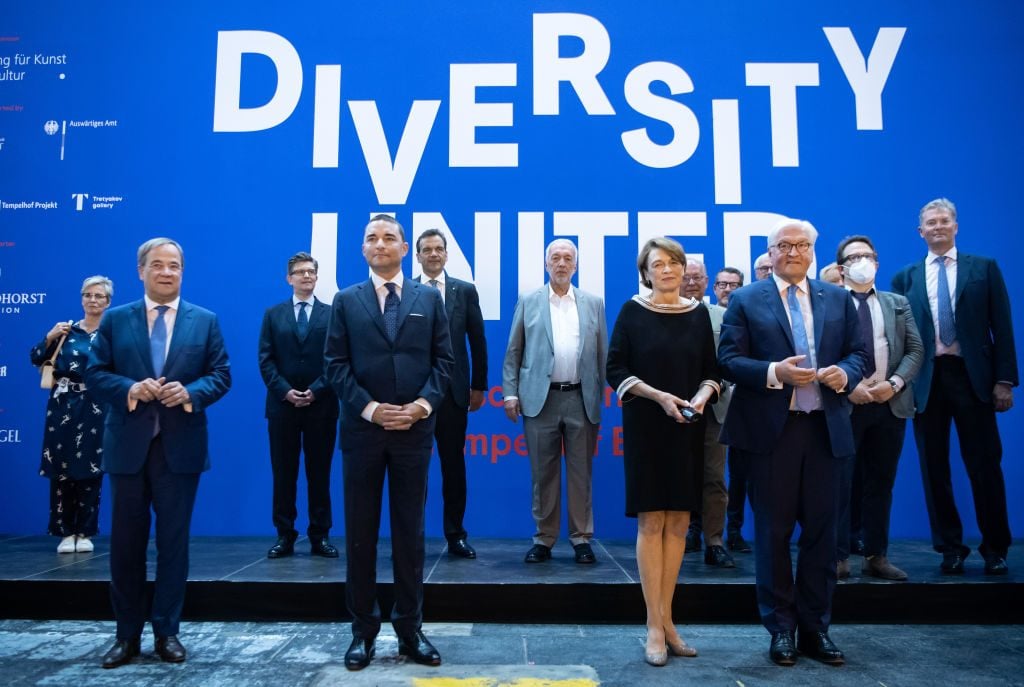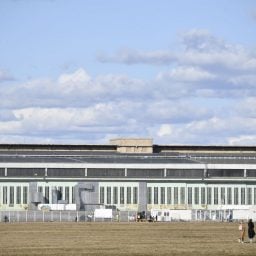The irony of Vladimir Putin giving his blessing to a European exhibition themed around democracy and freedom wasn’t the only oddity at “Diversity United,” a blockbuster show that opened earlier this year at Berlin’s former Tempelhof Airport.
Unlikely political entanglements seem to run deep in the ambitious group exhibition, which brought together 90 artists from 34 countries, including major names like Olafur Eliasson and Georg Baselitz, across two historic airplane hangers in Berlin (through October 10). Focused on “European values,” the exhibition was originally due to open in Moscow before it traveled to Berlin and Paris, prominently backed by the presidents of the three respective host countries.
Due to pandemic restrictions—as well as concerns about possible censorship of its Russian iteration—the planned debut at Tretyakov Gallery in Moscow was deferred, leaving the German capital to launch the show’s first chapter. Perhaps it was a sensible shift in plans given that the project was the brainchild of a household name in Germany’s art world, the Bonn-based non-profit Stiftung für Kunst und Kultur e.V. and its founder Walter Smerling. But the Berlin edition and its organizers soon faced criticism over various issues, including sources of funding, the white, male-only advisory council, and complaints of non-payment from participating artists.
Some of these concerns are not new. Smerling’s foundation has had a controversial history when it comes to overlaps between culture, industrial financiers, and politics. But these issues are gaining new prominence across the art world as institutions from the Sackler-backed Victoria & Albert Museum to the BP-sponsored British Museum come under heightened scrutiny about the sources of their funding.
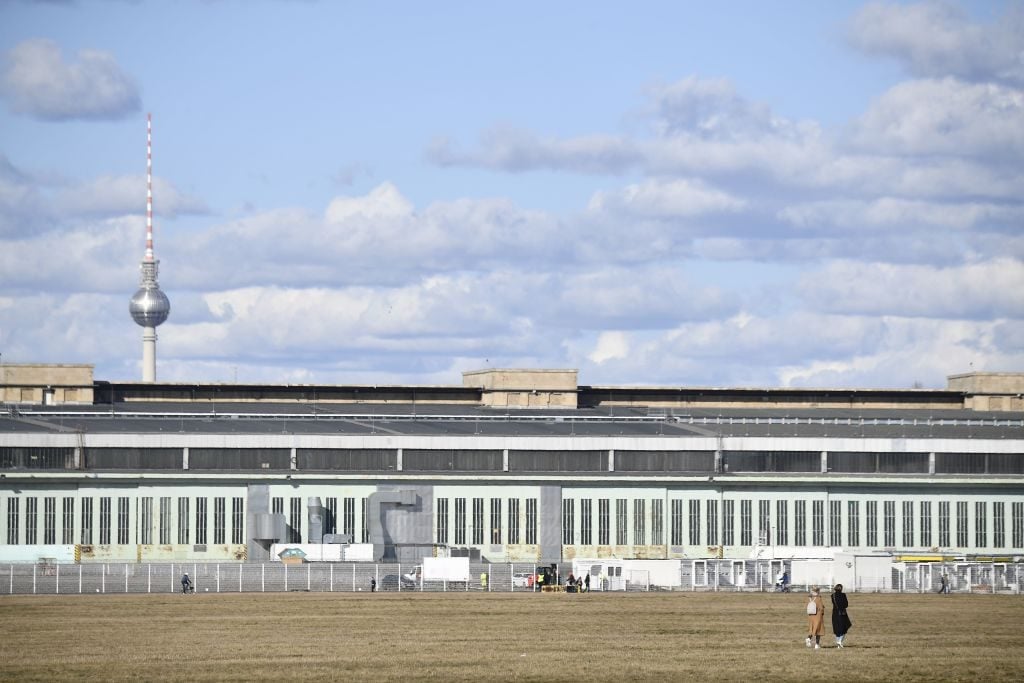
Berlin’s former Tempelhof airport. Photo: Tobias Schwarz / AFP via Getty Images.
A Building at the Heart of Europe
Tempelhof, the exhibition grounds of “Diversity United,” is an emotional space for Berliners, and it was hard-won. The exhibition’s presence there may be part of a longer game to determine the fate of the storied venue.
The former airport was built by the Nazis and the area once housed the notorious Columbia concentration camp. After World War II, it was the site of the Berlin Airlift, a major crisis that broke out when Soviet officials halted land traffic to the western-controlled sectors of Berlin. During the Cold War, the venue served as a terminal for American military aircraft before it became a commercial airport in West Germany. Decades on, Berliners rallied to keep the tarmac as a public green space and the building available for events. One of its more crucial uses recently was as a location for refugees during the recent migrant crisis, but it had also hosted the now-defunct Berlin Art Fair.
Fast forward to 2021: When “Diversity United” opened after unavoidable setbacks brought on by the pandemic, a show about Europe seemed well-suited to its location. Nevertheless, a number of local artists were not happy. Some said that the use of such an important public site was problematic because the organizers did not pay participating artists while the city of Berlin gave them access to the space for free.
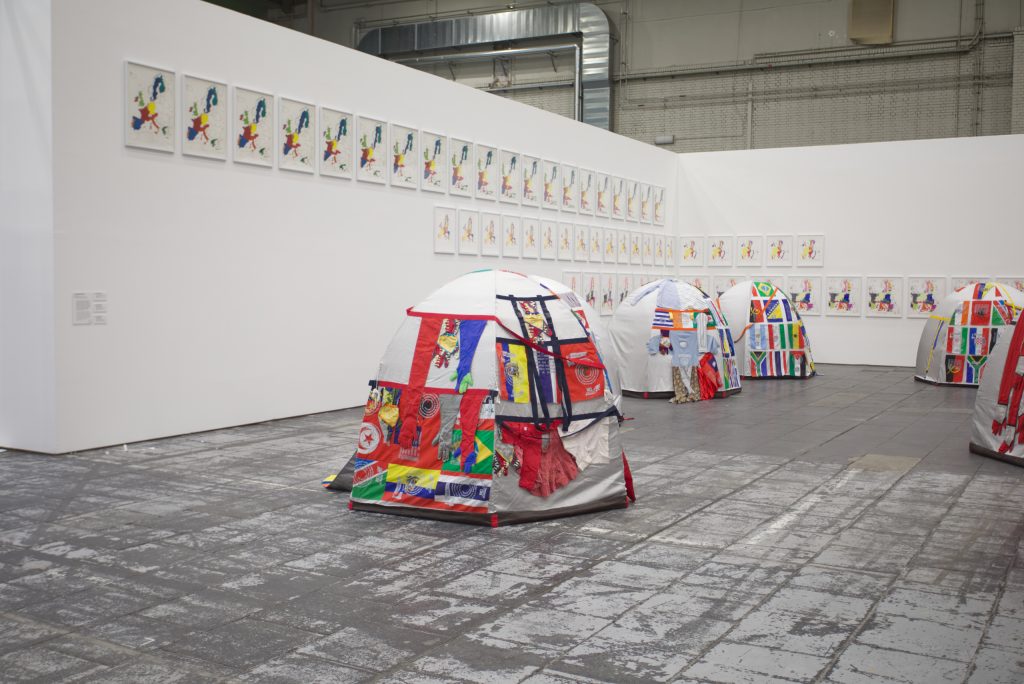
Diversity United. Flughafen Tempelhof Berlin © Stiftung für Kunst und Kultur, Bonn Foto: Silke Briel / © VG Bild-Kunst, Bonn 2021
“It’s problematic that an exhibition with an obviously enormous budget that uses public infrastructure fails to pay the artists. We need to change the premise that everybody in the art industry except the artists themselves earn,” said Zoe Claire Miller, a speaker of bbk berlin, the professional association of visual artists in Berlin. Some of the artists, she claimed, participated in hopes of selling works through Smerling’s network of wealthy collectors.
The curator refutes this. “I’m the wrong addressee in this case,” he told Artnet News. “We presented the circumstances under which we could realize this exhibition very clearly and all 90 artists were eager to participate. Under the difficult conditions of the pandemic that hit us, too, we are glad we could realize the exhibition and were able to pay production costs for many of the works on display plus travel expenses.”
The Federal Foreign Office confirmed to Artnet News that it had initially funded “Diversity United” with €500,000 ($577,268) in 2020. For 2021, another €500,000 ($577,268) have been promised.
Among the participating artists were established names like the late Christian Boltanski, Gilbert & George, and Annette Messager, alongside emerging figures like Slavs and Tatars and Ahmet Öğüt (shortly after the opening, Öğüt left the show and had his work and name removed). All of the artists have a unique connection to Europe, and most of the works, especially those from the Eastern hemisphere, touch poignantly on democratic ideals of freedom, justice, and equality.
But the show received criticism for its board of advisors, which was entirely all-white and male, standing in stark contrast to the title and thematics. Smerling told Artnet News it was not an intentional decision.
Henrike Naumann, one of the younger artists on display, was eager to participate in the cross-country exchange. “There are many colleagues I respect a lot, and one of the pivotal reasons for me to be part of this show was to show my work to a Russian audience at Moscow’s Tretyakov Gallery for the first time,” she told Artnet News.
As the show plans were underway, its organizers found out that Putin had blacklisted two German NGOs, the Centre for Liberal Modernity and the German-Russian Exchange that are included in the bilateral open forum between the nations, the Petersburg Dialogue. In the midst of cooling relations between the two nations, the Russian president said collaboration with German associations related to the Petersburg Dialogue could result in prison sentences. Smerling called off the exhibition’s Russian chapter in response.
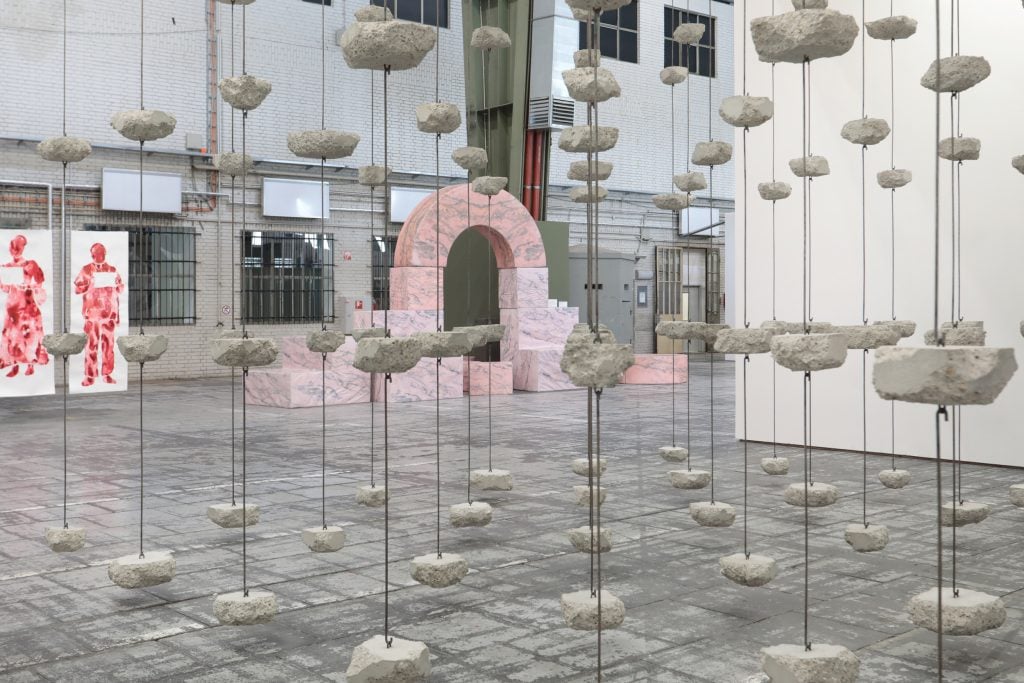
Diversity United. Flughafen Tempelhof Berlin © Stiftung für Kunst und Kultur, Bonn Foto: Silke Briel / © VG Bild-Kunst, Bonn 2021
A Long Game
Grand political plays aside, it seems that Smerling has his own play in the works for Tempelhof. Artnet News has learned that he has proposed turning Tempelhof into a privately-run exhibition venue.
“We showed that the hangars at Tempelhof work wonderfully as art halls and, after the overwhelmingly positive feedback to our show, decided to make a proposal for a couple of years: a private-public project, potentially in dialogue with the local scene,” Smerling said.
Although he insists it is an entirely different project, it is difficult not to see some similarities with his co-founding of the Museum Küppersmühle, a private museum in Düsseldorf he helped establish as a private public-partnership together with the city of Duisburg under the patronage of different private donors. Küppersmühle was built by Herzog & de Meuron at the expense of the city at a publicly-owned industrial harbor, and then was bought by art collectors Sylvia and Ulrich Ströher in 2005.
In Berlin, an association of artists had already been contact with the city for years with its own community-based, low-cost concept. “Rather than just glossy exhibitions, we want Tempelhof to become an accessible space where artists and residents can make things, exchange ideas, participate, where rooms can be used collaboratively, and where materials can be shared and repurposed,” said Corinna Weiner, a speaker of the artist-led group AG Tempelhof.
The former airport is technically large enough to host them both, but Weiner said AG Tempelhof has not yet been in contact with Smerling’s team. The whole scenario is, in any case, a matter of financial capacity. “The buildings are in ailing condition, maintenance costs of the big hangars run into the ten thousands per day,” she explained. “Only large-scale exhibitions with financial backing can afford to occupy this building, so it’s a matter of regulations and financial potency.” On paper, that makes a seasoned veteran like Smerling a shoo-in.
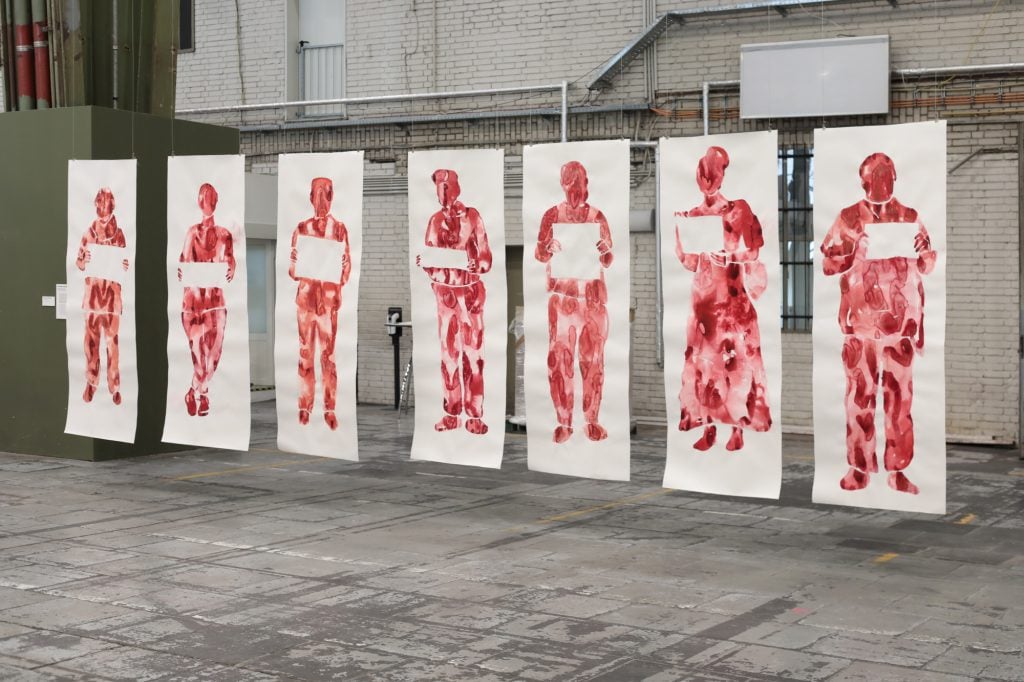
Diversity United. Flughafen Tempelhof Berlin © Stiftung für Kunst und Kultur, Bonn Foto: Silke Briel / © VG Bild-Kunst, Bonn 2021
Art and Business
Smerling and his foundation, which was founded in 1986, have faced repeated criticism regarding what some allege are opaque entanglements with politics and business. The notoriously productive art manager has a reputation realizing large-scale, ambitious global exhibitions backed by a formidable network of sponsors. But not everyone is on board with his financial partners. When he organized the two-part exhibition “China 8” and “Deutschland 8,” in 2015 and 2017, some of the participating artists, including Hito Steyerl, distanced themselves from the project because of one of its sponsors, arms producer Rheinmetall.
One sponsor in the Diversity United show has attracted particular notice from journalists in recent years. Besides car manufacturer Daimler and German fast fashion retailer New Yorker, the show is sponsored by Meridian Capital, a company prominently featured in the Paradise Papers for its connections to Kazakh oligarchs. Smerling didn’t specify the sum or nature of Meridian’s contribution, and said he was unaware that they were featured in the major leak that detailed offshore investments.
“We are crystal clear about our projects and our sponsors,” he said. “All our sponsors are listed in the invitations to the participants. Over more than 30 years, we have conceived and realized ideas in dialogue with different parties. And most of the artists and institutions have been extremely positive and happy to work with us again.”
Participating artist Naumann is well-aware of the criticisms surrounding the show. “My participation doesn’t mean I align with the political agenda of the patrons or sponsors,” she said. “The exhibition was under fire for the obvious use of art for political purposes, but I think it would be more interesting to discuss as to which political and economic objectives are to be achieved through this. As an artist, I ask myself how to navigate through and position myself within these structures.”
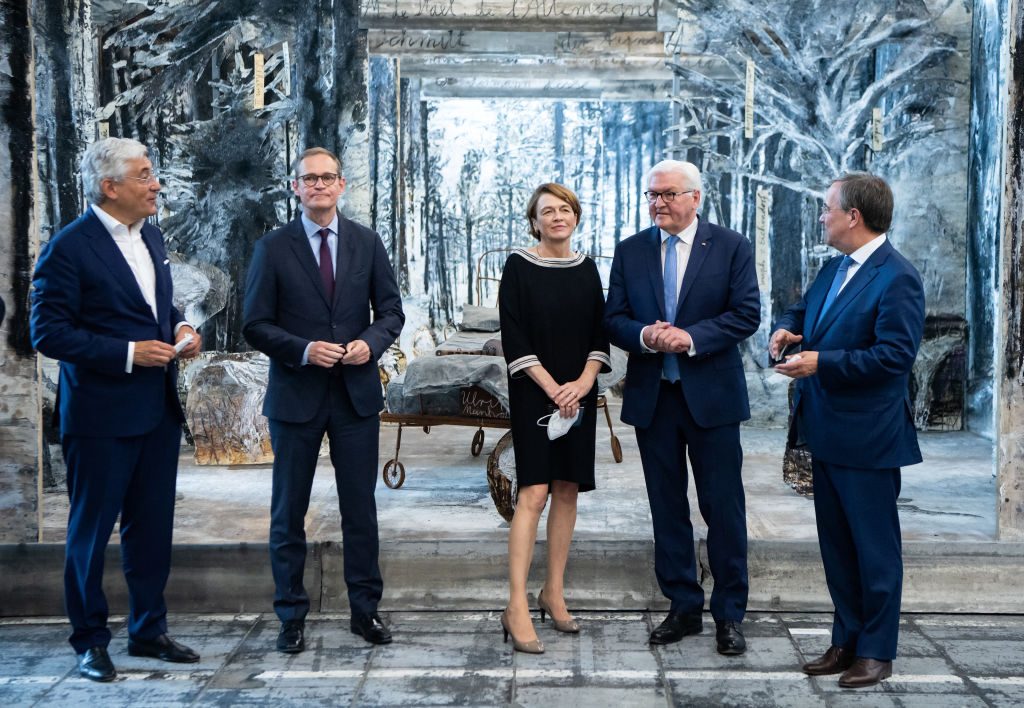
Federal President Frank-Walter Steinmeier and his wife Elke Büdenbender are guided through the exhibition “Diversity United” by Walter Smerling (left), Berlin mayor Michael Müller (2nd from left), and Armin Laschet (right) chancelor candidate and minister President of North Rhine-Westphalia stand in front of a work by Anselm Kiefer. Photo by Bernd von Jutrczenka/picture alliance via Getty Images.
An Uncertain Future
Diversity United’s opening on June 8 was graced by a number of influential figures and powerful officials: German president Frank-Walter Steinmeier, Berlin mayor Michael Müller, and chancellor candidate Armin Laschet. Another major sponsor of the exhibition, the art patron and financier Lars Windhorst, was also present.
It remains to be seen what the outcome will be once “Diversity United” closes on October 10, and once ticket sales (and, perhaps, artist sales) are tallied into its cost-benefit equation. The presence of such influential figures from the financial and political realms could tip the fate of Tempelhof in Smerlings’s favor. His foundation has already handed in a proposal to run the space as an art hall for several years—hoping to set up what he calls a “private-public partnership.”
Whether politicians will go for this is unclear, but in the wake of local and federal elections last month, what is certain is that major change is underway in Berlin, for better or for worse.
Yet already, there are lessons to be learned: as public space becomes more rare in a rapidly gentrifying Berlin, the political and financial networks that have enabled such ambitious projects are facing increasing scrutiny, and the proximity to questionable figures from the world of politics and business may change the conduct of exhibition-making in the future.
